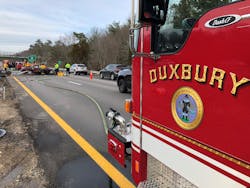Firehouse World 2020: A World of Good
Firehouse World in Las Vegas is a can’t-miss event for high-quality training and education. For those who can’t make it to the show this year, we compiled information from some of the educational sessions. Seek out additional information from the show at Firehouse.com or on social media using #FHWorld20.
The Hat Dance: Realities of the Short-Staffed Company
By Marc Aloan
Transitioning from the jump seat to the front seat is arguably one of the greatest challenges most will face in their fire service career. Even with sufficient preparation and progressive development programs in place, navigating the promotion to company officer can be difficult, particularly with short staffing. Still, many prospective officers enter this journey armed only with strategies found in formal training and with education that’s designed for staffing models that no longer are realistic for the average fire department. With a strong company officer often being the difference between failure and success on the fireground, we must reconsider what we ask of our company officers and how they carry out their duties.
As adequate staffing continues to become more of a fantasy than a reality for fire departments of all shapes and sizes, company officers are being asked to wear many hats each tour, ranging from tailboard firefighter to command level officer and everything in between. Those who work as members of a crew that has three or fewer personnel must actively balance firemanship and leadership to overcome the shortcomings of limited manpower. The ensuing “hat dance” requires today’s company officer to jump from role to role as he/she adapts traditional supervisory practices to short-staffed cultures, which demand not only their influence but their participation, too. In such situations, the archaic practice of the officer who operates independently from the company will cause them to fail both in and out of the firehouse. Instead, modern company officers must bridge departmental, personal and community expectations by embracing the opportunity to function as working bosses.
When staffing inadvertently blurs the lines between boss, mentor, peer and partner, a set of well-thought-out and communicated expectations helps maintain clarity in most situations. These expectations, combined with a commonsense approach to delegation, instruction, discipline and humility, allow the team to focus on what needs to be done instead of who has done what. There no longer is a place for concrete responsibilities or inflexible roles when personnel are at a premium. Nowadays, everyone on the ticket needs to enter the fireground with the realization that we are all firefighters first, which is a mentality that slowly has eroded over the years. This means blending the traditional roles and responsibilities that maintain order in our firehouses with innovative strategies that employ all hands on an incident to complete mission critical tasks in a timely manner.
Contrary to one of the more popular staffing sound bites, we never will do more with less. Instead, we must continue to work toward solutions that deliver the service that our communities have come to expect, with the staffing that we can provide. To do so, company officers must remain engaged in moving the team forward, despite the setbacks that low staffing creates. Whether we are on a crew with just one person or just one crew in the firehouse, we need to evolve some of our most coveted traditions to preserve morale, maintain competency and build comradery in the process. All it takes is a little forward thinking, encouragement, empowerment and perspective for the low-staffed company officer to build a strong team and lead them to success. Remember, the color of the lid never will be as important as the person who it protects. Regardless of the rank that adorns us, everyone’s collar is blue on the fireground. No matter what, the best thing that we can do is the job that needs to be done.
Marc Aloan is a career captain with the West Columbia, SC, Fire Department, a volunteer firefighter with the Hephzibah, GA, Fire Department and creator of The Fire Inside blog. He has been a member of the fire service for 16 years and is a veteran of the U.S. Air Force. He speaks nationally, including courses on culture, leadership and professional development. His writing has been published in the “Firemanship Journal” and the “Fire Department Training Network Newsletter,” among others. Aloan holds a bachelor’s degree in fire protection administration from Eastern Kentucky University and is pursuing his master’s degree in organizational leadership from Waldorf University.
Social Media for Today’s Fire Service
By Rob Reardon
For years the fire service has relied on others to tell our story. Social media has changed that, because it allows you to talk directly with the taxpayers. However, it’s important that you are consistent when telling your story before you start on social media.
We often assume that people know what we are doing, but, truthfully, many people believe that all we do is fight fires.
There are two types of messages that I normally post: emergent and informational. The emergent messages include weather warnings that our citizens need to see immediately. Also, when firefighters are at an accident scene, they can deploy a message to alert commuters of the location while showing crews working.
The informational/educational messages highlight the many things that firefighters do that our customers might not be aware of. A great example: an elevator rescue that Duxbury, MA, Fire Department ran. Immediately after, I had some regret for putting out something seemingly trivial. The next day, a citizen came up to me and said she had no idea that we did elevator rescues, and she shared how she showed the post to all of her friends. This is a perfect example of a very simple operation that many of us do that our customers are not aware of.My department uses four social media channels, and you need to understand that each has a unique customer base:
- Twitter—News outlets use this as a way to gather news and photos that are posted directly on their platforms. This has replaced the press release for my department, because it makes for much faster turnaround times for news agencies and also gets the information to all of them at the same time.
- Facebook—This allows us to connect with more of the community. In our town, this is where we get a lot of interaction from the residents. It also allows us to receive praise and feedback about the work that our firefighters do.
- Instagram—This is where we connect with the younger generation. It’s a quick way to send out a photo with some basic information, but it provides little feedback.
- YouTube—We publish all of our videos here, and it’s one of the most popular search engines that’s out there.
When posting to Twitter, Facebook and Instagram, it’s very similar content, although dependent on the character count.
Before you hit the send button on a social media post, ask yourself whether your customers will want this information? I stay in my lane and don’t post information about what other agencies are doing or have done nor national news that doesn’t directly impact our customers.
Post in a language that followers can understand and avoid fire-specific jargon that your audience might not understand.
People’s time is valuable and limited, and you want to make the most out of every post.
Rob Reardon is a captain at the Duxbury, MA, Fire Department and has been in the fire service for 20 years. Prior to his fire service career, he was an award-winning photographer who worked in the television news industry and for major newspapers. He won national awards for his photography and for stories he has produced on firefighters. Reardon’s work has been published and televised around the world, including numerous cover shots for Firehouse Magazine. He also is the PIO for his department and has been featured on all national news networks in addition to local news channels.
Lessons Learned: Jackson Memorial Middle School Shooting
By Kai W. Rieger
On Feb. 20, 2018, a student at the Jackson Memorial Middle School in Massillon, OH, encountered a fatal self-inflicted shooting that involved a seventh-grade male student. This immediately made the middle school and all Jackson Local School District campuses to go into lockdown mode. Fire, EMS and law-enforcement agencies converged and began operations. The subsequent intelligence reported that this was the first step in a planned mass school shooting. The event went from a suicide to a large-scale operation within minutes.
Anytime that we have an incident of this size and type, we interact with a multitude of agencies. Fire/EMS, police departments, state patrol, FBI, county sheriff, SWAT, bomb squad and school administration all worked within their disciplines. This only can be successful with good pre-existing relationships.
We were faced with only one gunshot wound patient, which was quickly and efficiently treated and transported. What took several hours was law enforcement’s processing of the building. As expected, it was a lengthy duration to clear the hallways—each room was filled with teachers and students—and to move the occupants to a safe area.
After the school was cleared by law enforcement for safety, the next painstaking task was to check off each student and reunite him/her with a family member for dismissal. The Jackson Local School District administration was instrumental in this mission. As the occupants and families awaited final disposition, there were numerous calls for EMS for students—and parents in the crowd—who required medical attention. This was our largest call volume for EMS.
Some of the teaching points that came from this call were:
- radio and cell signals within the building (if attention is needed to maximize these services, the time to address them is now);
- effectiveness and efficiency of mass-casualty-incident (MCI) plans;
- training level of fire department and law-enforcement personnel for entry (Does your organization participate in active-shooter or Rescue Task Force trainings?);
- ballistic vest availability to all responders;
- weather (Will cold or heat exposure add to your problems? What are your options?); and
- mental-health capabilities (Does your organization have a system by which your employees can access mental-health care immediately? Again, if not, the time to rectify this is now.).
It takes a great deal of preparation to successfully mitigate a large-scale shooting incident. Handling the job with efficiency and professionalism is where the proverbial rubber meets the road.
Kai W. Rieger, who is a 30-year veteran of the fire service, is a battalion chief for the Jackson Township, OH, Fire Department. He is a graduate of the Ohio Fire Executive program and has a bachelor’s degree in industrial management and an associate degree in fire science. He instructs at local, state and national fire programs.
February 24–27, 2020 • Las Vegas, NV • #FHWorld20

